There are many things we would probably like to avoid in life and I think that head lice is probably near the top of the list. It’s a problem that many of us may have had in school but it can also affect adults as well.
More than likely, if you are looking at this article, you understand the pain associated with having lice. Whether it is you or a child under your care, it is the last thing you want to have to deal with.

Despite the fact that many people have suffered from this problem, there is a lot of misinformation associated with it. Thankfully, we have here to provide some expert advice from Lena Gorelik so we know the truth about those little critters.
Q: What Are Lice?
A: According to Lena, head lice are tiny wingless parasites that feed on human blood. They start out as nymphs and through three different phases, grow to a full-grown louse.
Q: What Are Nits?
A: Quite simply, nits are lice eggs. The female lays them on hair shafts along with a substance that acts like cement to hold them in place. They will remain on the hair shaft for about eight or nine days until they hatch. The shell will then be left behind, and the shell is also called a nit. It’s easy to see why head lice are often mistaken for dandruff.
Q: What Do They Look like?
A: A full grown head louse is about as big as a sesame seed. She went on to say that the baby lice are grayish white or tan and tend to blend into the hair. After they feed on you, the abdomen fills with blood so they take on a brown tint.

Q: How Do You Get Ice? Can They Jump from Someone Else’s Head onto Your Head?
A: You will be happy to know that head lice cannot fly, hop, or jump. They simply crawl so they spread through direct head-to-head contact in most cases. You can also catch head lice from sharing a hair comb or brush, although it is not likely.
Q: Where Do Head Lice Appear?
A: You will see the nits as tiny brown, yellow, or white teardrops attached to the hair shaft. They are extremely tiny and are typically found about 1/4 inch from the scalp if they are unmatched.
“A healthy louse likes its home,” Lena explained, “it clings on to an individual’s hair as this is where their home is, and will not willingly leave to go onto an inanimate object. When a louse is found on an object, it is likely in the process of dying.”
Q: Do They Always Make Your Head Itchy?
A: “While most people associate head lice with an itchy scalp,” Lena told us, “sometimes head lice produce no symptoms at all. The itching associated with lice is actually caused by an allergic reaction to the parasites saliva. Only about 60% of people will develop an itchy scalp.”
Q: Are There Really Super Lice?
A: Lice can become resistant to treatment if the treatment is not used properly or if they are overused. There have been some cases of super lice that are resistant to the over-the-counter medications that are commonly used.
Q: How Do You Get Rid of Head Lice Quickly?
A: There are no shortcuts but you can purchase a quality nit comb and comb the hair meticulously. You have to continue to comb it and if you use a product on your hair, you must read the instructions carefully. Unless you comb the nits out properly, the infestation will continue.



